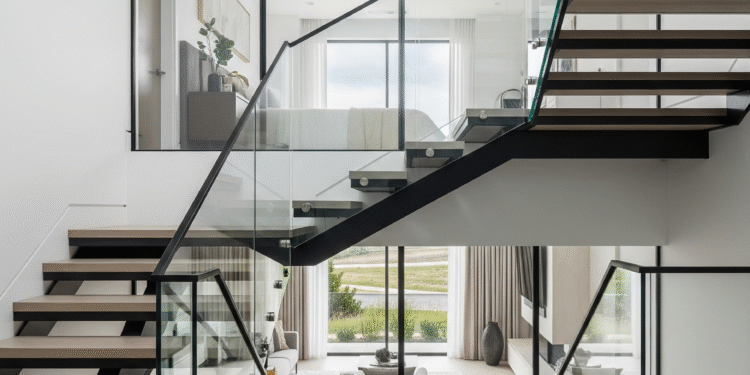Introduction
Stair Handrail ideas to Refresh your home’s staircase and update your railings! You’ve landed on the right guide! Whether you’re building from scratch or giving an older case a facelift, the right rail can change the whole feel of a room.
Your staircase is usually the first feature visitors see. It needs to be safe, but it should also look great. From sleek cable lines to warm timber banisters, today’s handrail choices let you match every personal style.
In this friendly guide well walk through cool handrail ideas, every kind of railing material, design styles that inspire, and down-to-earth tips so you can build the staircase your home deserves. Ready to lift your rooms? Lets jump in!
Understanding Stair Handrails vs. Railings: Whats the Difference?
Before we dive into styles, lets clear up a little jargon that trips up most folks. While many use handrail and railing as if they mean the same thing, each word actually points to a separate part of the stair system.
Handrails (sometimes called banisters) are the long bars you grasp for balance as you move up or down. Its the smooth line of support that runs alongside the treads and must stay steady from top to bottom. Think of the handrail as your personal safety rope on the climb
Railings, on the other hand, act like a sturdy fence that stops people from sliding off the edge of the stairs. This structure includes posts, balusters, cables, glass panels-anything that fills the space between floor and top to keep falls at bay.
Knowing the difference now will help you set a clear plan and talk smart with your contractor when it comes time to upgrade or build your new staircase.
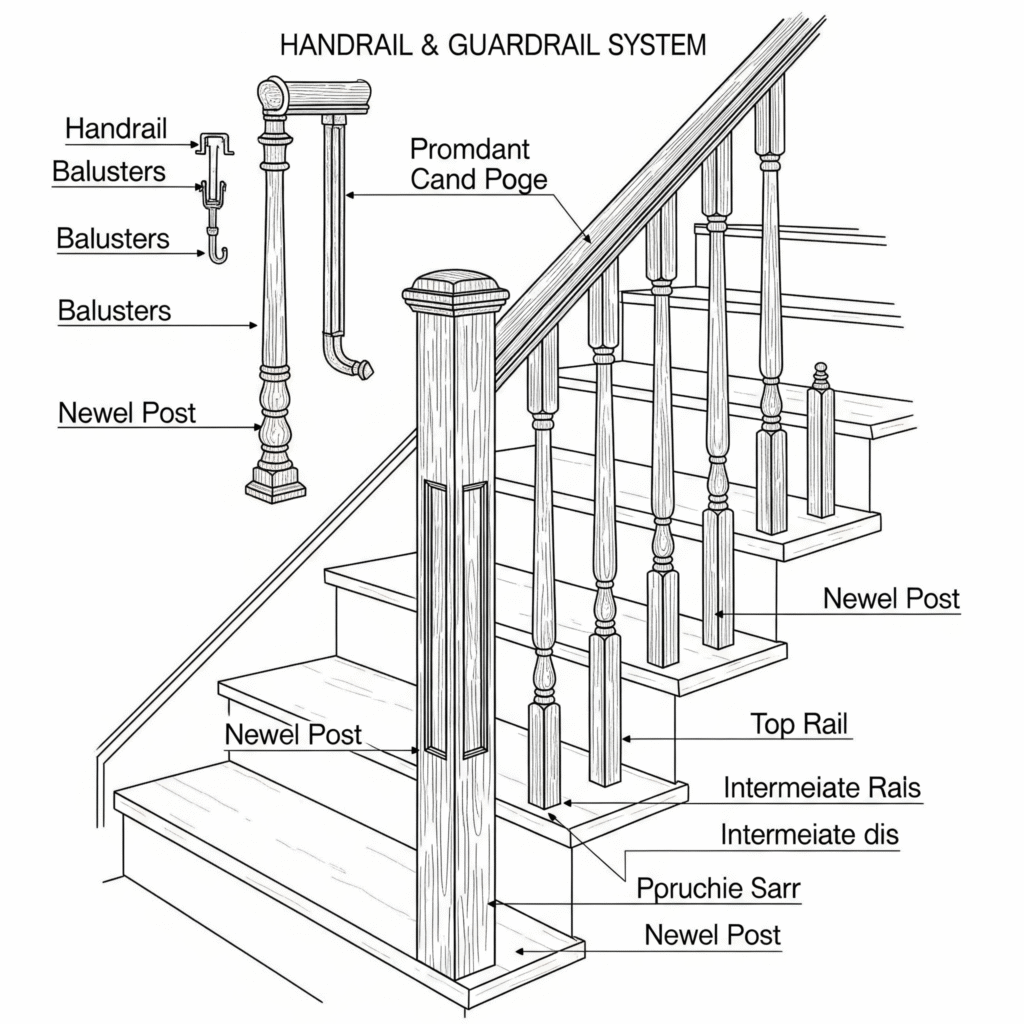
Relevance: Lets readers follow the trade terms used later in the post
Explore 12 Fresh, Modern Handrail Ideas for Your Stairs
1. Glass Panels for Unblocked Views
Glass panels give a sleek, airy feel to todays open-plan rooms. They also fit snugly on narrow staircases, as this project from Nash Design Group shows. Pair the glass with slim black metal tubes for added depth and contrast.
Why Glass Is Smart:
- Keeps sight lines clear throughout the house
- Lets daylight flow instead of trapping it
- Shrinks the visual bulk in tiny hallways
- Wiping it down takes minutes
Best For: Modern decor, compact stairs, spaces with scenery to showcase
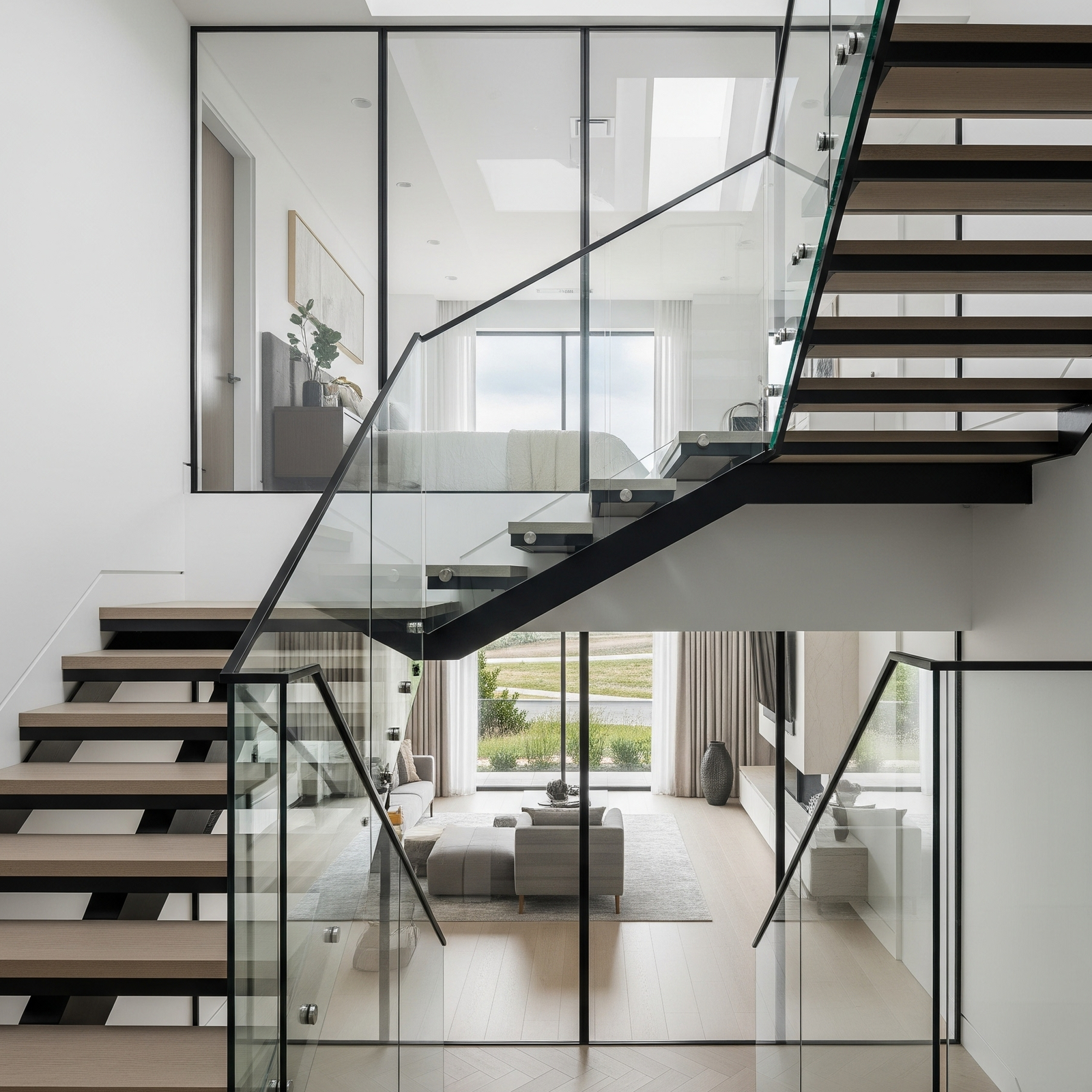
Care Tip: Mix equal parts white vinegar and water to wipe the glass and metal monthly. Stay clear of strong solvents to protect seals and frames. For streak-free shine, use a soft cloth.
2. Cable Railing Systems – Industrial Chic
Cable railings deliver a clean, trendy look that keeps winning fans. They fit decks and balconies perfectly-especially when you want to show off an impressive view. The slim wire lines almost vanish, so your eyes move straight to the scenery outside.
Cable Railing Benefits:
- Unobstructed views
- Low maintenance
- Weather resistant (when using stainless steel)
- Code compliant when properly installed
Material Options:
- Stainless steel: Tough and built to stand up to rain and salt air
- Aluminium: Lighter, easier to handle, and great for indoor jobs
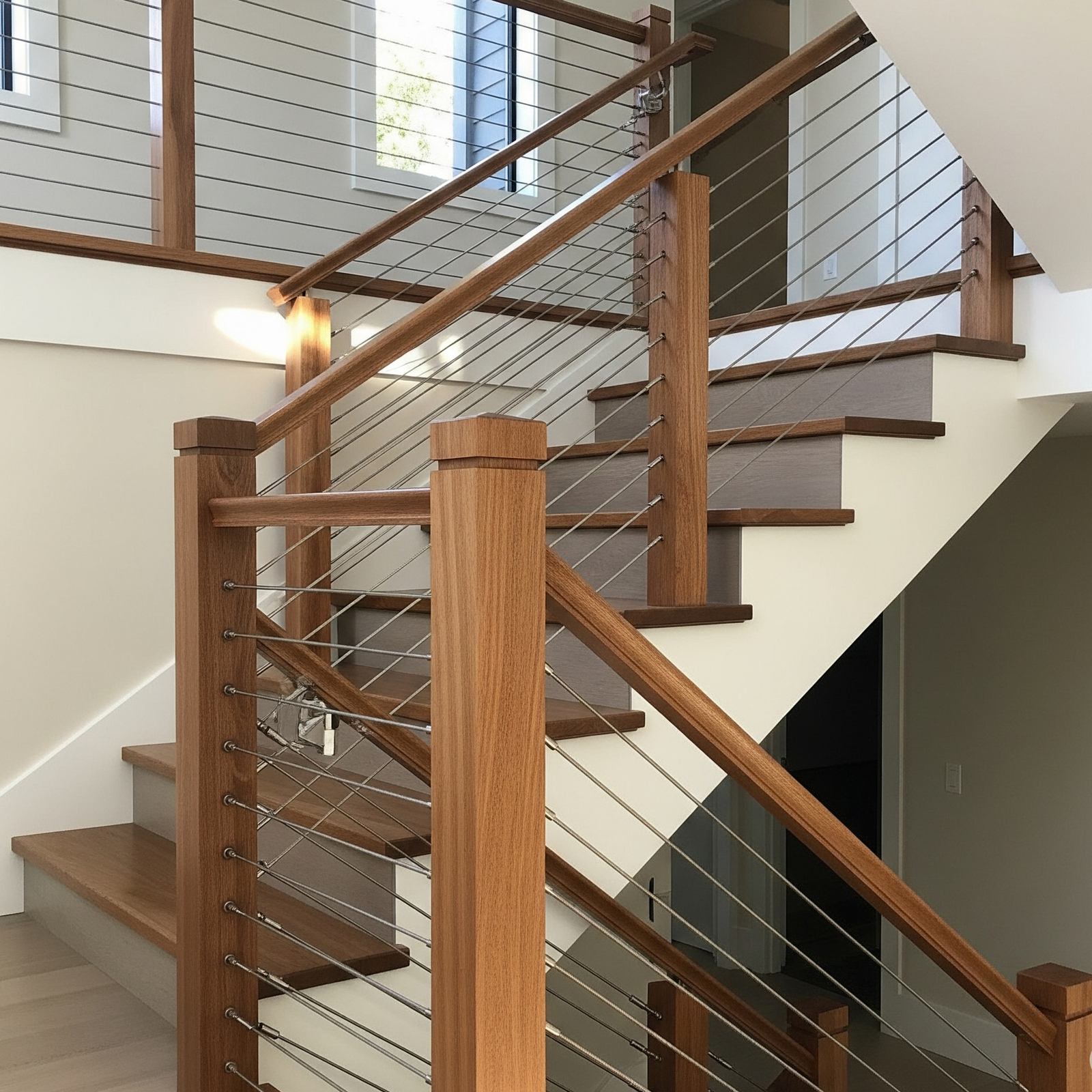
3. Black Metal Balusters – Bold and Striking
Tight rows of sleek black spindles form a stair railing that grabs attention fast. Set against pale walls, the dark finish gives contrast and adds depth to an otherwise calm room.
Quick Design Tips:
- Pair with white or light walls for contrast
- Fits easily into both classic and edgy looks
- Add wrought iron if you want fancy detail
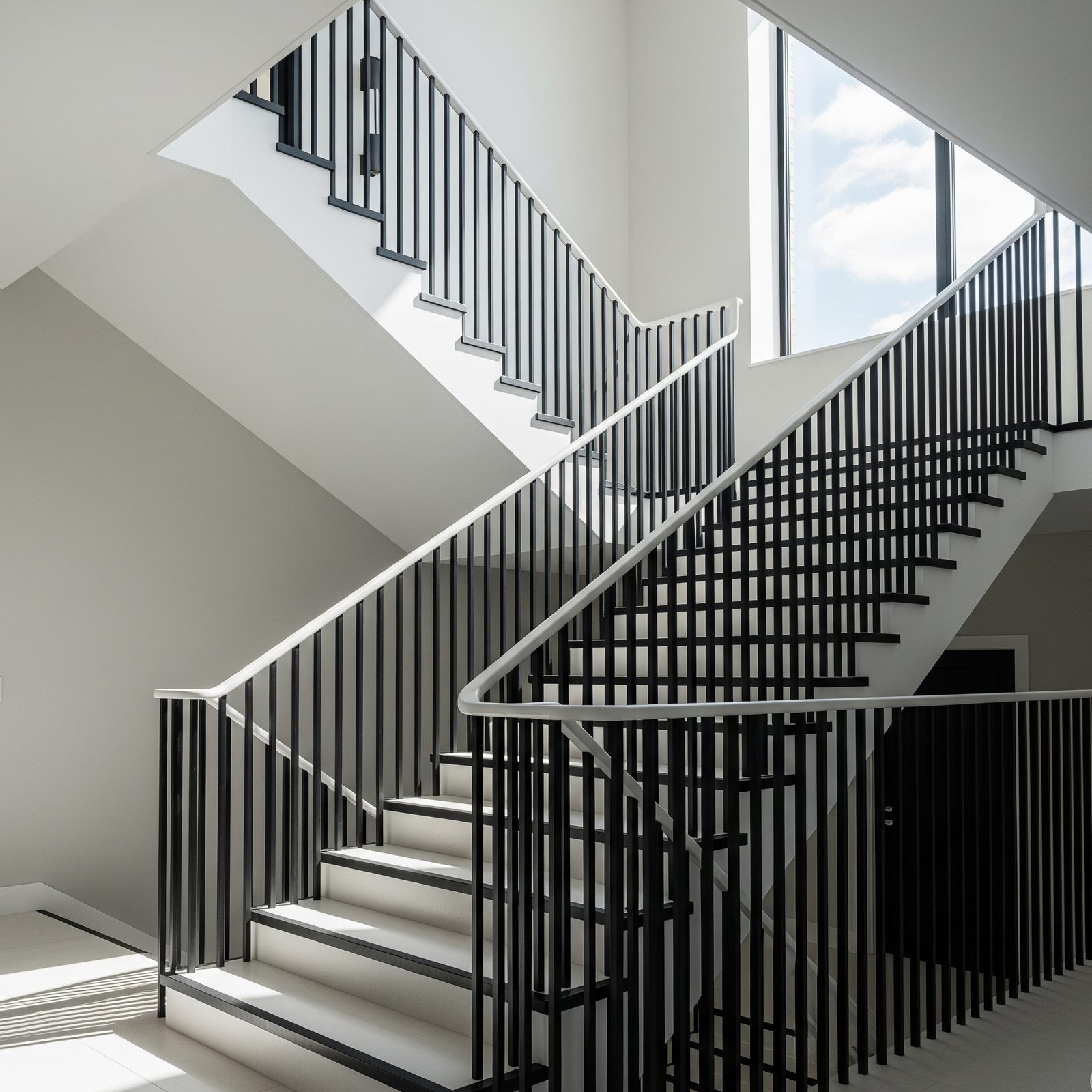
Relevance: Example of popular dark-light color mix
4. Wood and Metal Mix – Best of Both Worlds
Combining wood and metal keeps things fresh and lets you pull bits from different styles. This railing pairs rustic warmth with modern edge. Horizontal metal bars sit against warm wood caps and newels, putting a fun twist on the usual country look.
Common Pairings:
- Wood rail with metal balusters
- Metal frame with wood panels
- Wood posts with cable strands
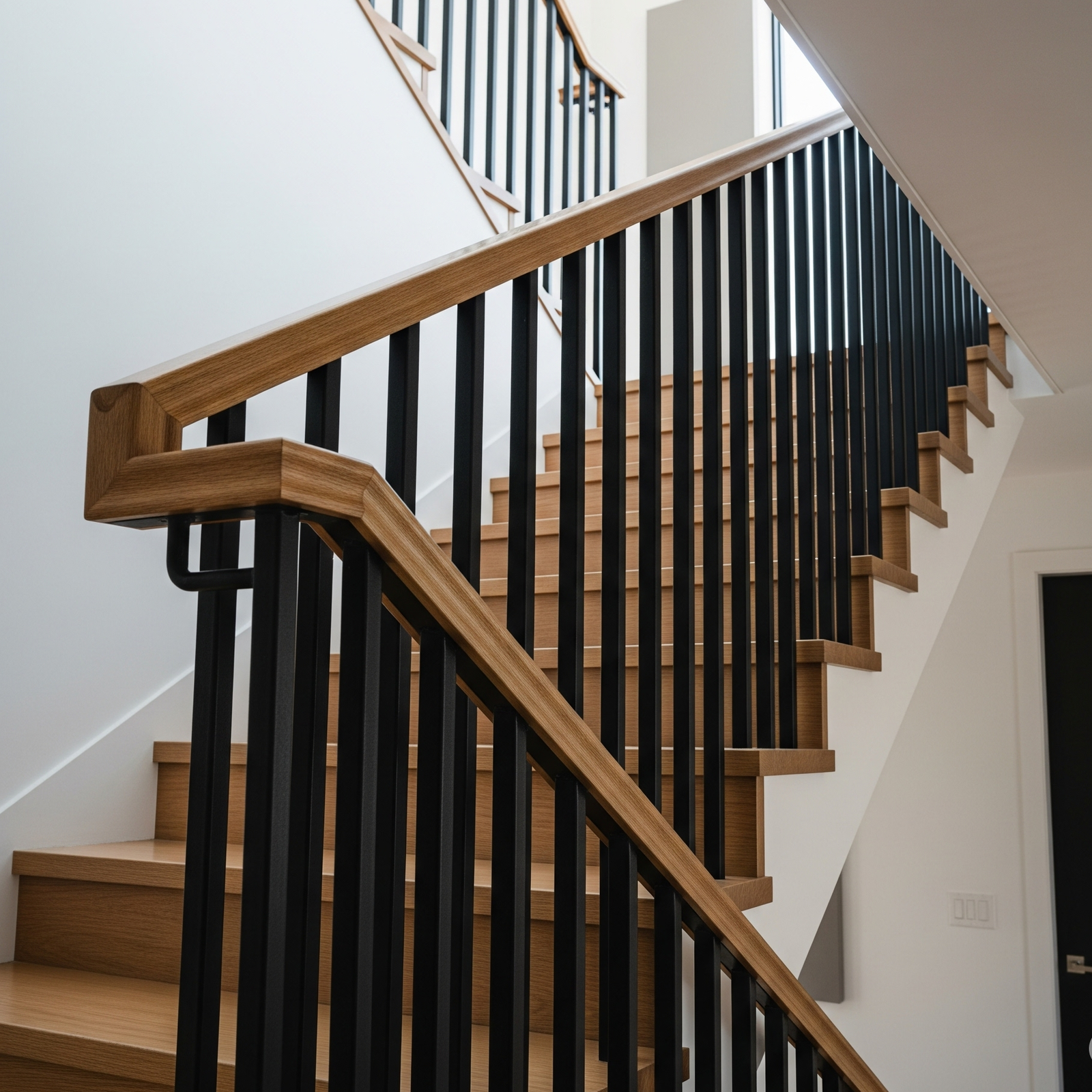
5. Floating Stairs – Instant Drama
Mark Odom Studios floating stairs let light spill through each tread and bar. Watch how shadows shift as beams slide over the open steps.
Key Features:
- Steps float in mid-air, almost as if by magic
- Simple, slim handrails keep the look clean
- Ideal for open-concept, modern houses
- Makes a bold statement in any room
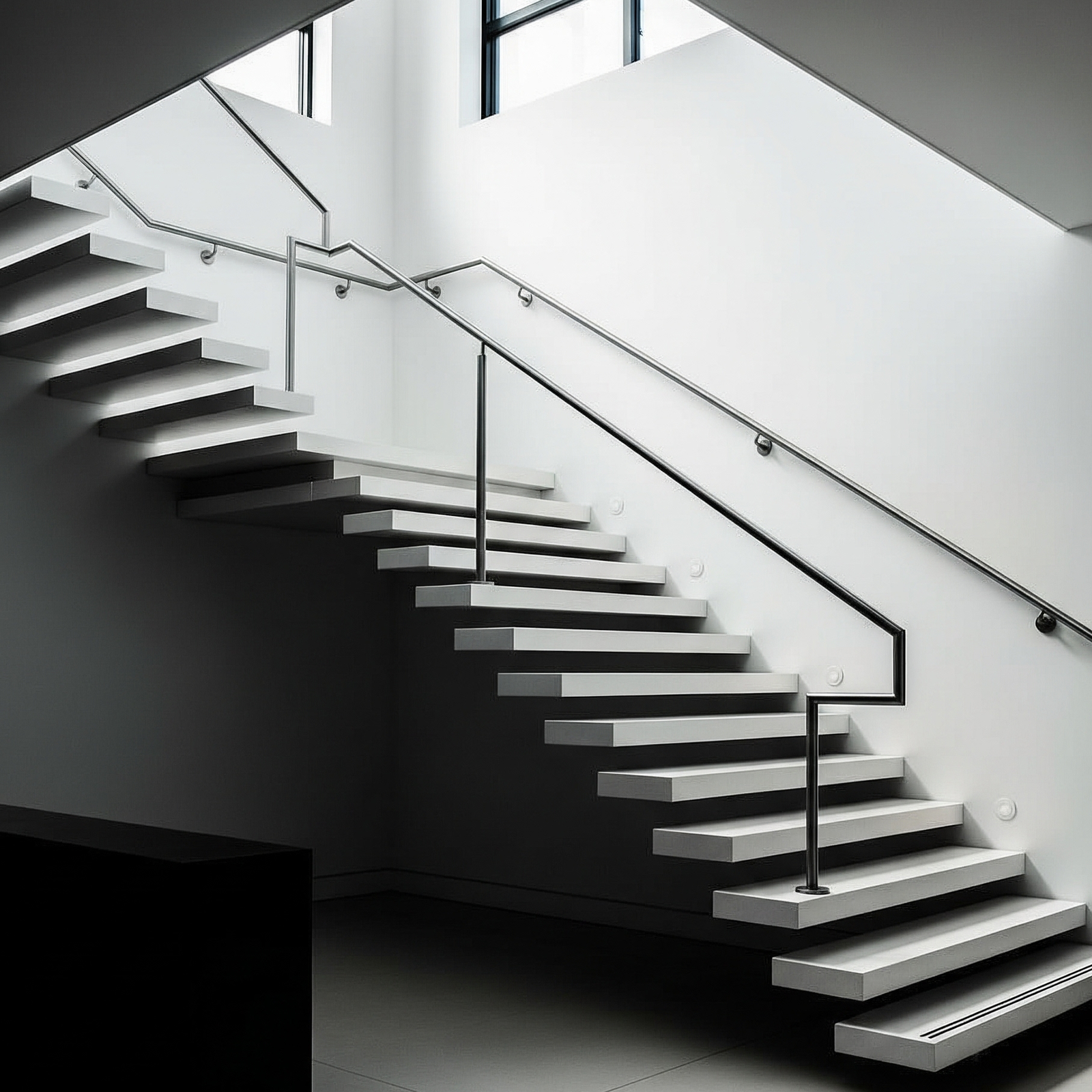
Warning: Floating Stairs
Floating stair cases need a pro both to design and to install them. Local codes may limit their use, and homes with small kids or older adults should think twice because the risers are open.
6. Classic Wooden Railings – Always in Style
This timeless railing seen in the 2019 Whole Home Tour in Atlanta pairs a stained wood top with white risers and balusters, matching warm treads.
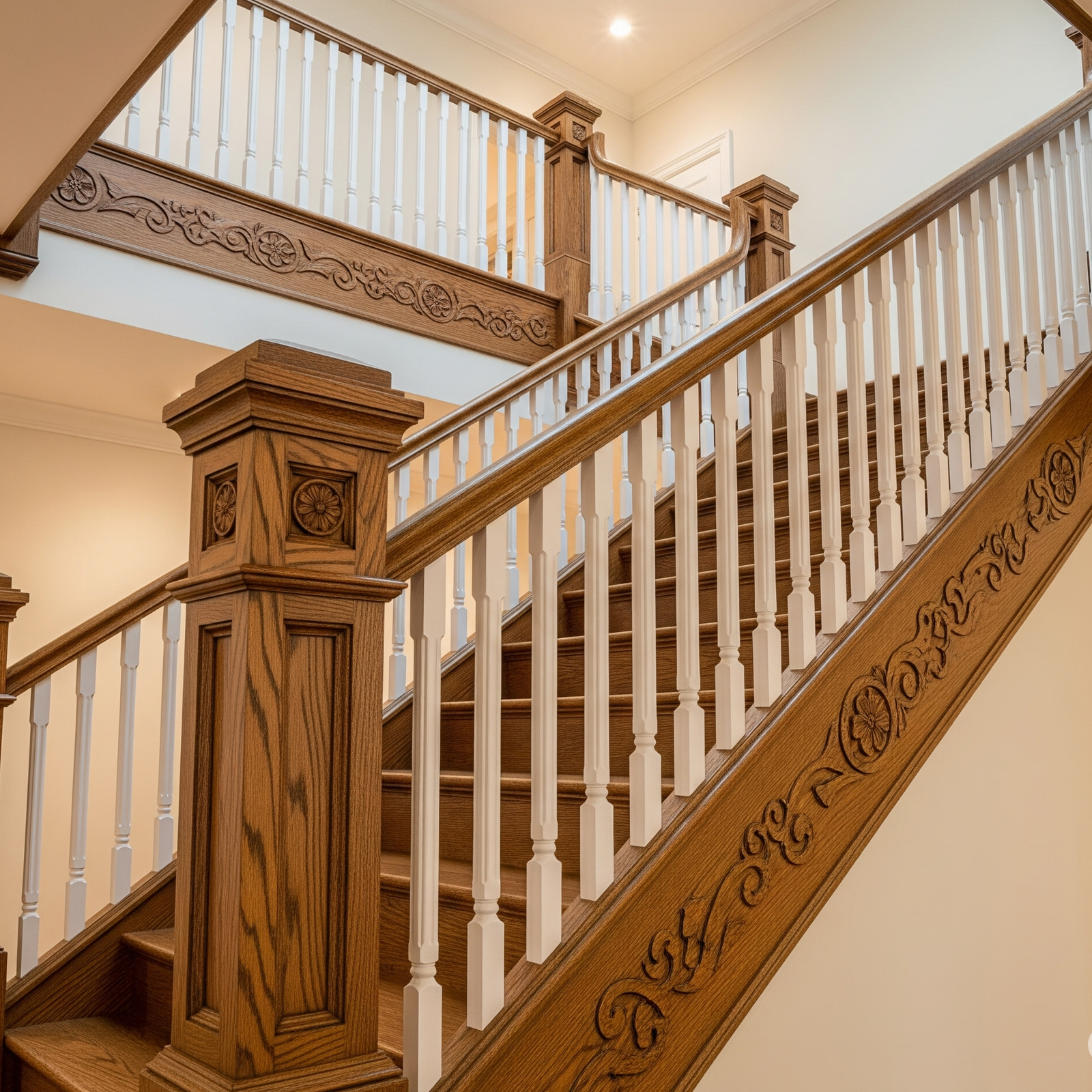
Best Woods for Handrails:
- Oak: Tough and classic
- Maple: Light, smooth
- Cherry: Deep, warm
- Mahogany: Rich, dark
7. White Painted Railings – Fresh and Airy
Crisp white paint on the balusters brightens stained treads and the hand rail. Because it works with almost any color, white trim can also make rooms feel bigger.
Natural Warmth – Simple Style
- Pair with natural wood handrails for contrast
- Works in both traditional and contemporary settings
- Easy to touch up and maintain.
8. Curved and Spiral Designs – Elegant Flow
This gently winding staircase by MMB Studio features an elegant, high-polish wooden handrail that matches the steps. Its ultra-slim spindles, topped with small decorative knobs, and a tan-hued runner tie the look together.
Design Considerations
- Requires skilled craftsmen for installation
- More expensive than straight railings
- Creates stunning focal points
- Works best in larger spaces
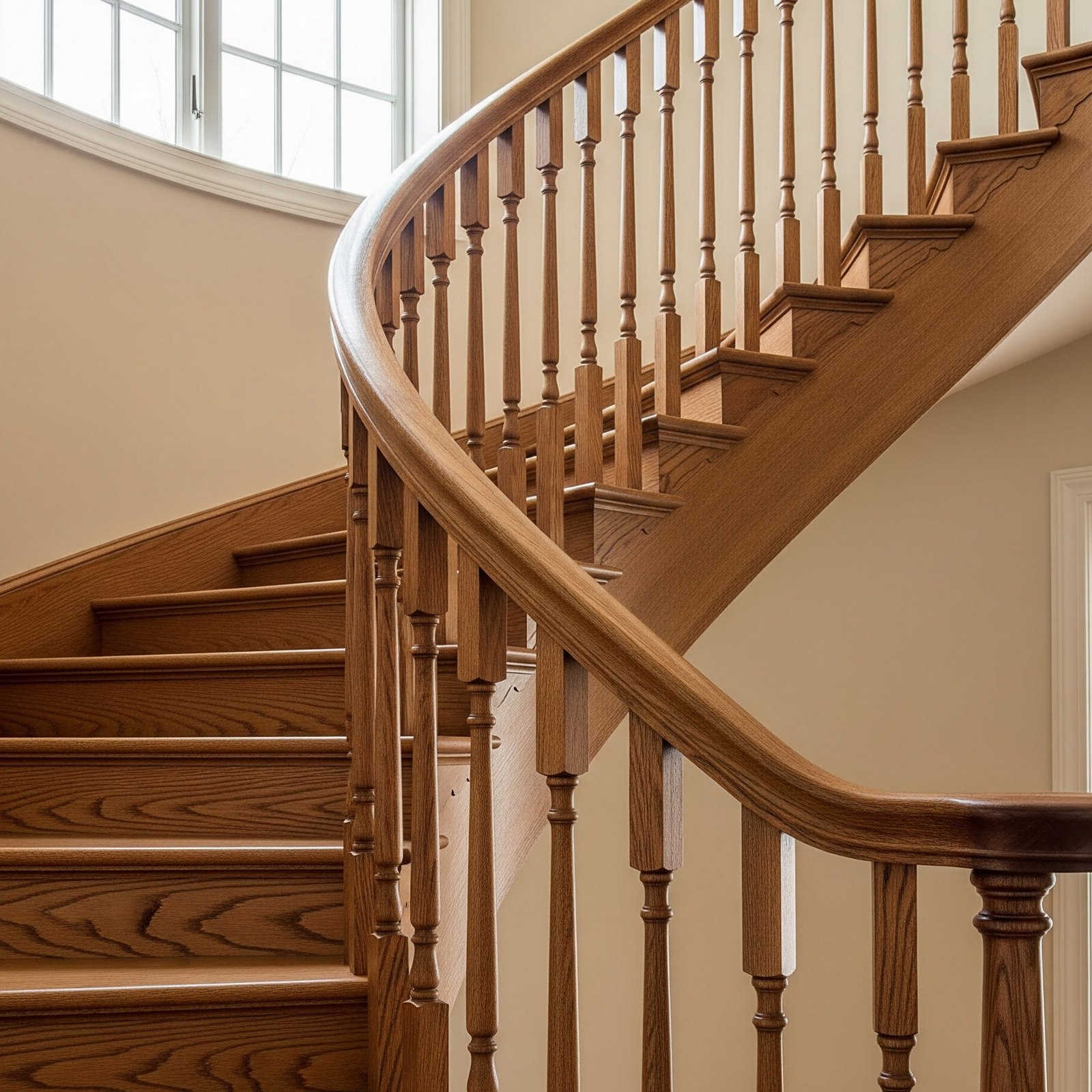
Relevance: Demonstrates premium curved railing design
9. Two-Tone Railing Designs – Visual Interest
A two-tone railing gives this classic staircase a fresh twist. Recreate it by painting the balusters and newel posts white while leaving their tops, the handrail, and the treads in natural wood or a matching stain.
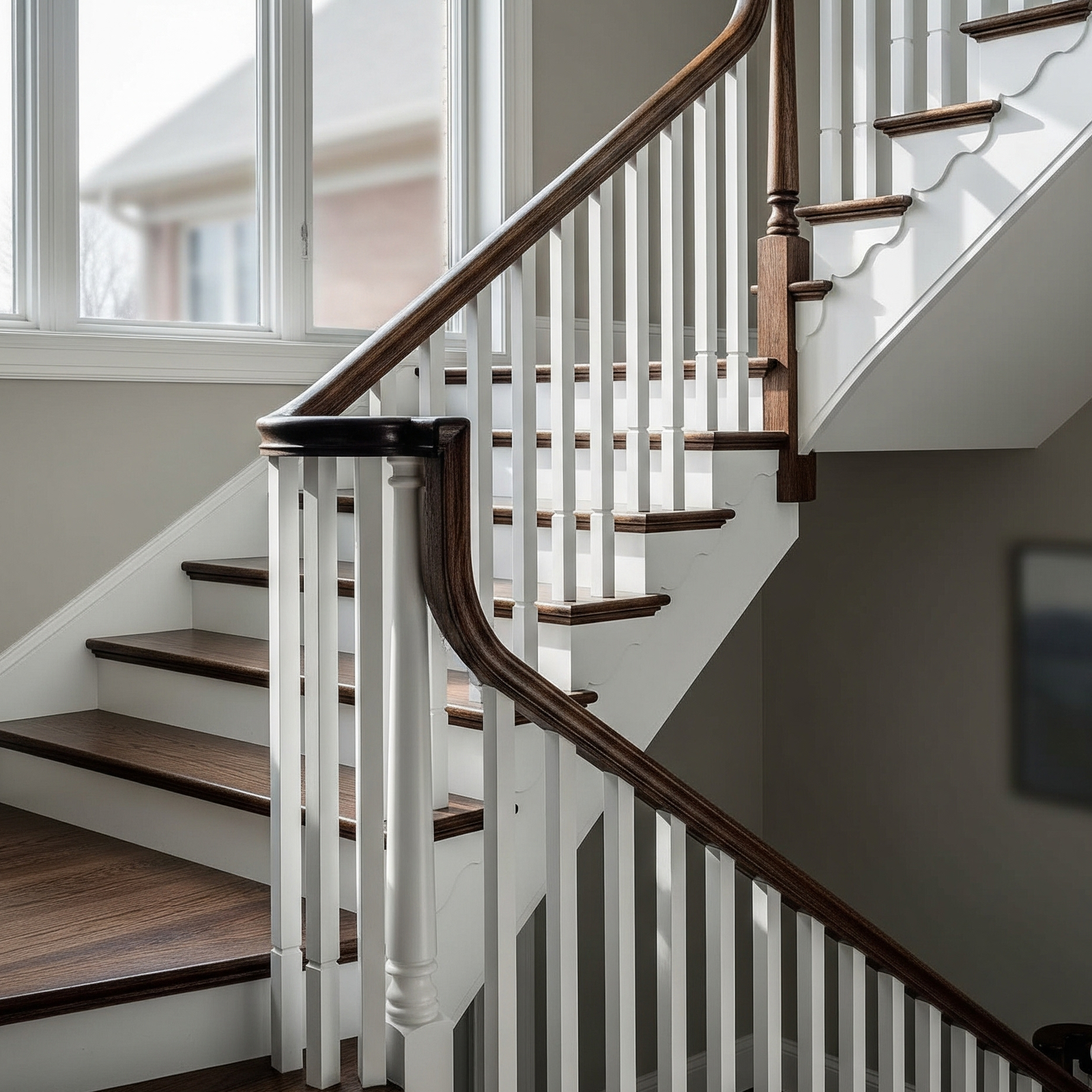
Popular Color Combinations:
- White balusters paired with a dark wood handrail
- Black handrail set against bright white balusters
- Natural wood finished with bold painted accents
10. Geometric and Cut-Out Designs – Artistic Flair
Cut-out shapes in the balusters can give a plain stairway new energy. Clean lines match the dark treads and risers and keep the look sharp.
Design Options:
- Square openings for a strictly modern vibe
- Circular cuts that soften the overall outline
- Custom shapes that show off each homeowner’s style
11. Wall-Mounted Handrails – Space-Saving Solutions
Great for tight halls or anyone after a super-clean, minimalist rail. A. Naber Design shows how a slender wood strip hugs the wall yet feels luxe. Matching the handrail to the treads gives just enough warm contrast.
Benefits:
- Saves precious floor space
- Easy to sweep and wipe underneath
- Friendly on the budget
- Can meet ADA rules if set right
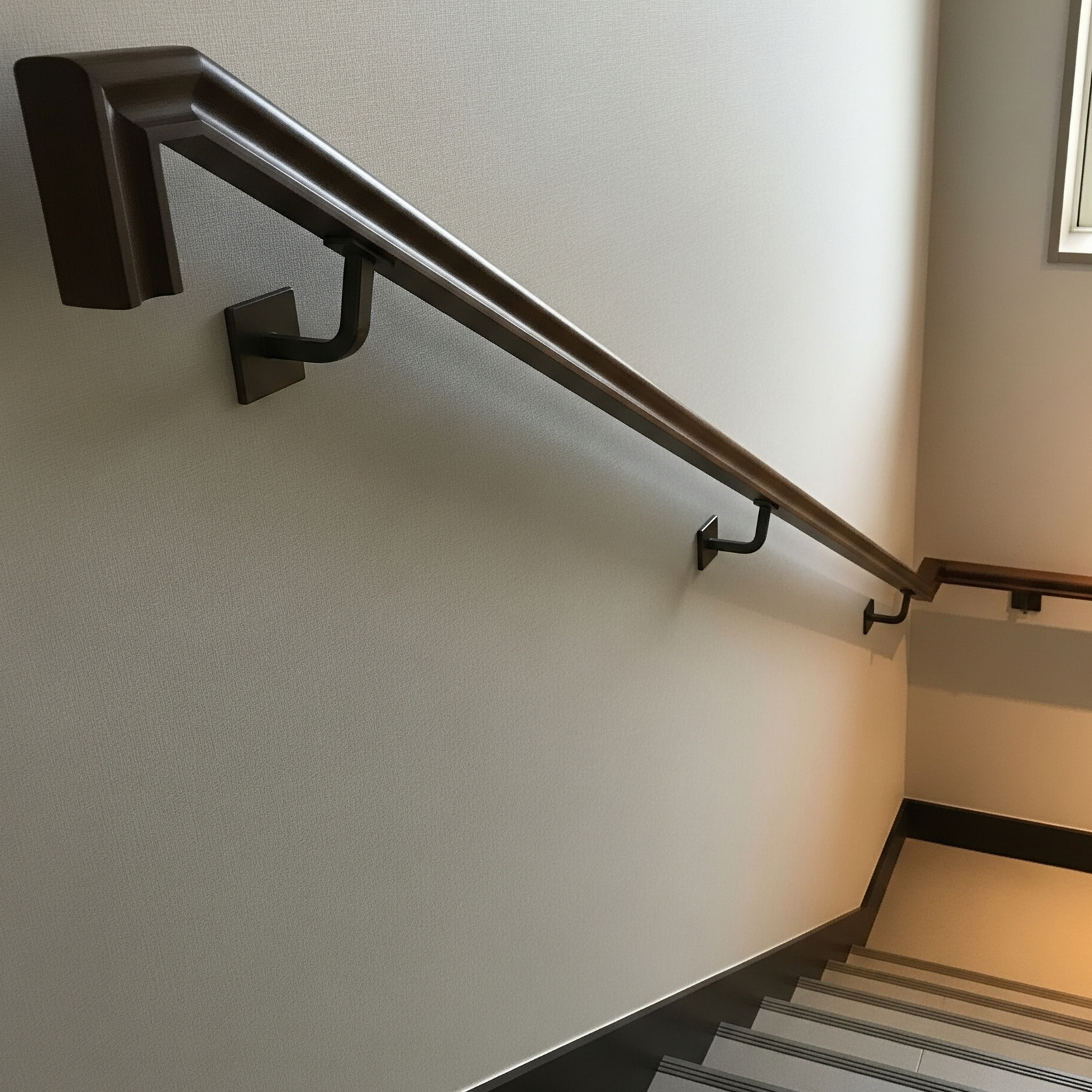
12. Mixed Material Modern Designs – Contemporary Innovation
Pairing whitewashed pine or warm maple with cool metal accents bridges comfort and edge.
Trending Combinations:
- Glass panels held in place by metal frames
- Wood handrails matched with taut cable infill
- Solid stone posts topped with sleek metal balusters
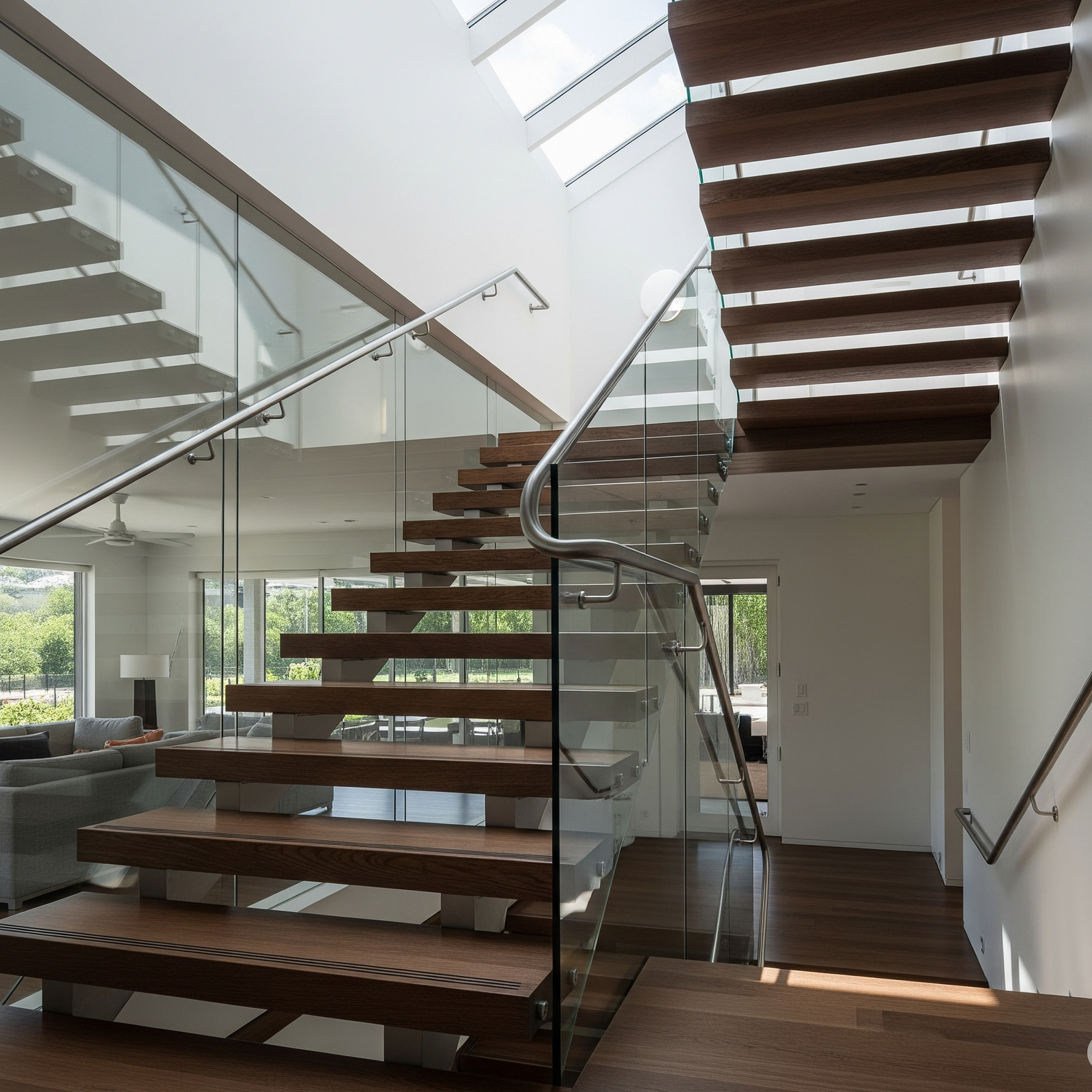
Relevance: Example of today’s mixed-material design trend.
Staircase Railing Materials Guide – Pros and Cons
Wood Railings
Pros:
- Gives a warm, classic look
- Paint, stain, or sand to any color
- Usually budget-friendly
- Small dents can be fixed easily
Cons:
- Scratches and squeaks over time
- Humidity can twist or split wood
- Not the best choice for sleek, ultra-modern homes
Best Uses: Colonials, farmhouses, period-style interiors
Metal Railings
Types of Metal:
- Steel: Heavy-duty but rusts without paint.
- Aluminum: Light and immune to saltwater.
- Wrought Iron: Curly and classic, yet costly.
- Stainless Steel: Bright, modern, and very rust-resistant.
Pros:
- Stands up to abuse and weather
- Just wipe to keep it nice
- Tolerates flame and sparks
- Fits clean, minimalist looks
Cons:
- Can be chilly on bare skin
- Higher price than wood
- Custom forms require welding
Glass Railings
Pros:
- Effortlessly opens up stair landings
- Smears wipe off in seconds
- Gives a high-end, gallery feel
- Lets sunlight pass, brightening rooms
Cons:
- Shows fingerprints and water spots
- Can be pricey when budget is tight
- May crack or shatter-use tempered glass
- Not suitable for every home style
Quote Box: Industry Expert Insight
“Glass railings feel modern and open a room, yet only tempered glass properly installed keeps them safe for years.” – Architectural Digest Design Expert
Cable Railings
Pros:
- Unobstructed views
- Clean, modern, industrial look
- Low upkeep beyond the occasional wipe
- Tension and spacing can be custom ordered
Cons:
- Typically pricier than wood or metal
- Pro install recommended for safety
- Some local codes may still ban them
- Dust and pollen settle in cable grooves
Budget-Friendly Stair Handrail Ideas
DIY-Friendly Projects
Paint Transformation:
A fresh color changes worn wood in minutes. Pick a bold hue or classic white to match decor.
Cost: $50-$150 for paint and brushes
Time: Weekend project
Skill Level: Beginner
Simple Baluster Replacement:
Swap tired spindles with sleek new ones while leaving the handrail in place. Select pre-cut styles for easier measuring.
Cost: $200 to $500, based on the materials you choose
Time: One to two days on average
Skill Level: Intermediate beginner-you should be comfortable with power tools
Wallet-Friendly Material Options
Pine wood railings: $15 to $25 per linear foot
Standard metal balusters: $10 to $20 each
Vinyl railings: $20 to $35 per linear foot
Composite decking material: $25 to $40 per linear foot
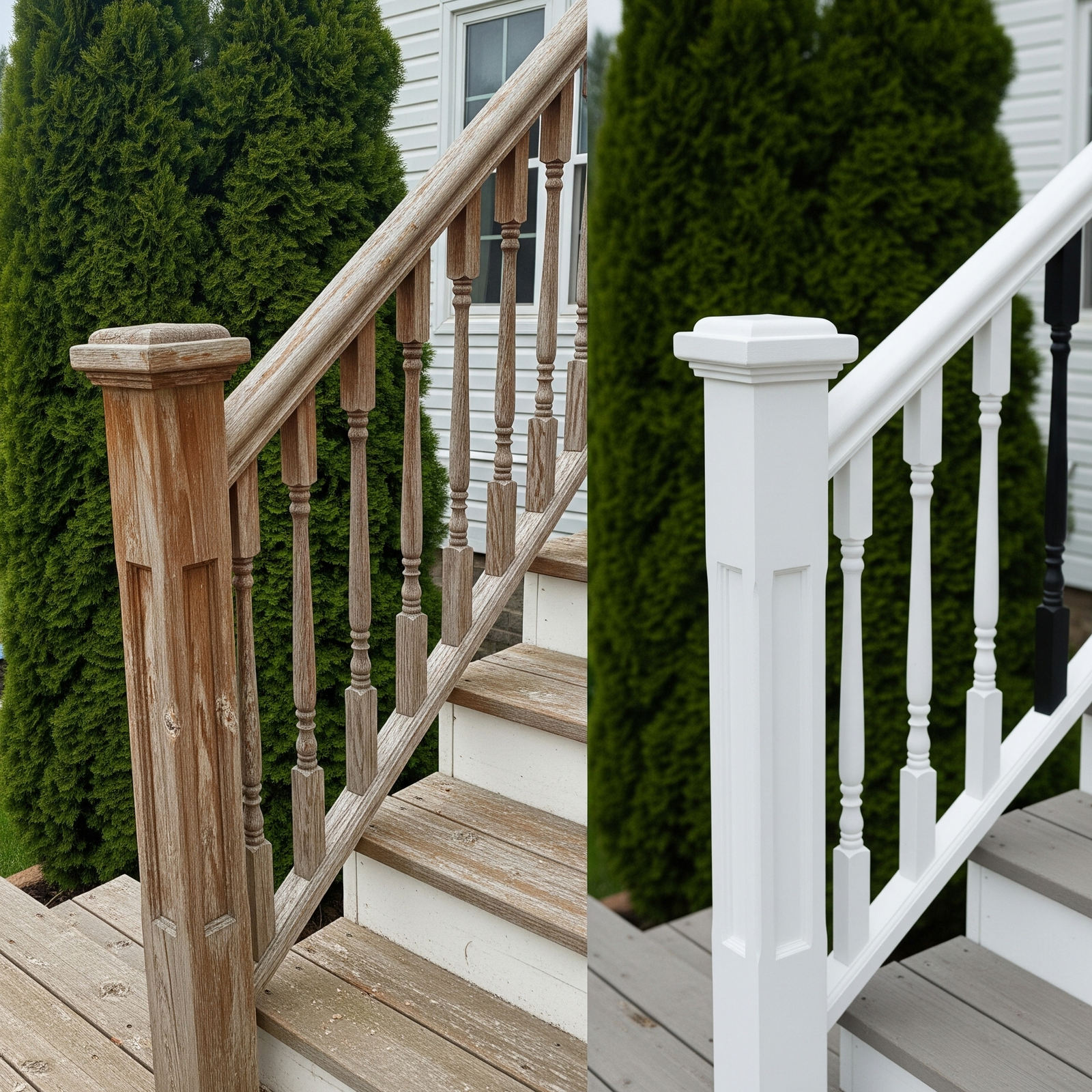
Relevance: Demonstrates affordable transformation possibilities in a budget-friendly stair project
Safety Considerations and Building Codes
Essential Safety Requirements
Height Requirements:
- Residential jobs need the top rail at least 36 inches above the tread nosing
- Commercial jobs raise that bar to 42 inches
Baluster Spacing:
- Keep gaps a maximum of 4 inches so small kids or pets cannot squeeze through
- Every section should resist at least 200 pounds of outward push
Handrail Specifications:
- Rail diameter must fall between 1.25 inches and 2 inches so most hands can grip it easily
- Handrails should run the full length of the stairs, uninterrupted from top to bottom
- Smooth, rounded edges are a must; no sharp angles that could slice fingers
Warning Box: Code Compliance
Local codes may differ, and they change now and then. Study the rules set by your town or city before you swing a hammer. If the job alters the main frame, a seasoned pro might need to step in.
Child Safety Features
Consider These Options:
- Keep baluster spacing under 3 inches.
- Round corners on every surface.
- Use tempered glass, not regular.
- Skip horizontal rails kids could climb.
Installation Tips and Professional vs. DIY
When to Call a Professional
- If you change stair framing.
- For cable-railing setups.
- When adding glass panels.
- On curved or spiral styles.
- For landings that link multiple floors.
Benefits of Hiring Experts
- Meets local codes.
- Solid, tested support.
- Includes warranty.
- Gives peace of mind.
DIY-Friendly Projects
Easy Jobs You Can Tackle:
- Paint or stain metal or wood.
- Swap out bent balusters.
- Add caps, brackets, or scrolls.
- Set up wall-mounted handrails.
Basic Tools Youll Need:
- Cordless drill and bits.
- Small level.
- Measuring tape.
- Circular or miter saw.
- Goggles and mask.
Maintenance and Care for Different Railing Types
Wood Railing Care
Regular Maintenance:
- Dust weekly with a microfiber cloth.
- Deep-clean monthly with wood-safe soap.
Quick Care Guide for Railings
Wood Railing Maintenance
- Inspect for damage every three months.
- Refinish every three to five years.
Signs You Need Refinishing:
- Scratches, scuff marks, or deep dents.
- Color fading or odd patches.
- Surface feels rough or splintery.
- Water rings or swollen boards.
Metal Railing Maintenance
Stainless Steel:
- Wipe with mild soap and warm water.
- Polish with stainless steel spray.
- Tighten fasteners once a year.
Painted Metal:
- Dab touch-up paint on chips right away.
- Repaint the entire surface every five to seven years.
- Scan for rust spots after heavy rain.
Glass Railing Care
Weekly Cleaning:
- Spray glass cleaner or a vinegar mix.
- Wipe with a clean microfiber cloth.
- Clean both sides every session.
Quarterly Inspections:
- Look for chips, cracks, or scratches.
- Check that all hardware is snug.
- Examine seals and gaskets for leaks.
Design Trends and Future Outlook
Current Popular Trends
Minimalist Designs:
Today, railings do more than keep people safe; they add sleek style that lifts whole rooms.
Mixed Materials:
Wood, glass, metal-any combo shows personality and fresh flair.
Bold Contrasts:
Deep black metal atop pale wood or soft drywall gives each piece center stage.
Integrated Lighting:
LED strips and small bulbs tucked right inside the handrails.
Emerging Trends for 2025-2026
Sustainable Materials:
- Reclaimed wood you can actually see the history in
- Recycled metal parts that cut down on waste
- Finishes safe for people and the planet
Smart Integration:
- Controls built into the post or wall
- Handrails that heat up on the coldest days
- Links to the rest of your smart home
Curved and Flowing Designs:
Rails that bend and sweep, leaving straight lines behind.
What are the most popular stair handrail ideas for modern homes?
How much do different types of railings and staircases cost?
Wood railings: $50-$120 per foot
Metal railings: $80-$200 per foot
Cable railings: $100-$300 per foot
Glass railings: $150-$400 per foot
Pro installation usually adds another 50% to 100%.
